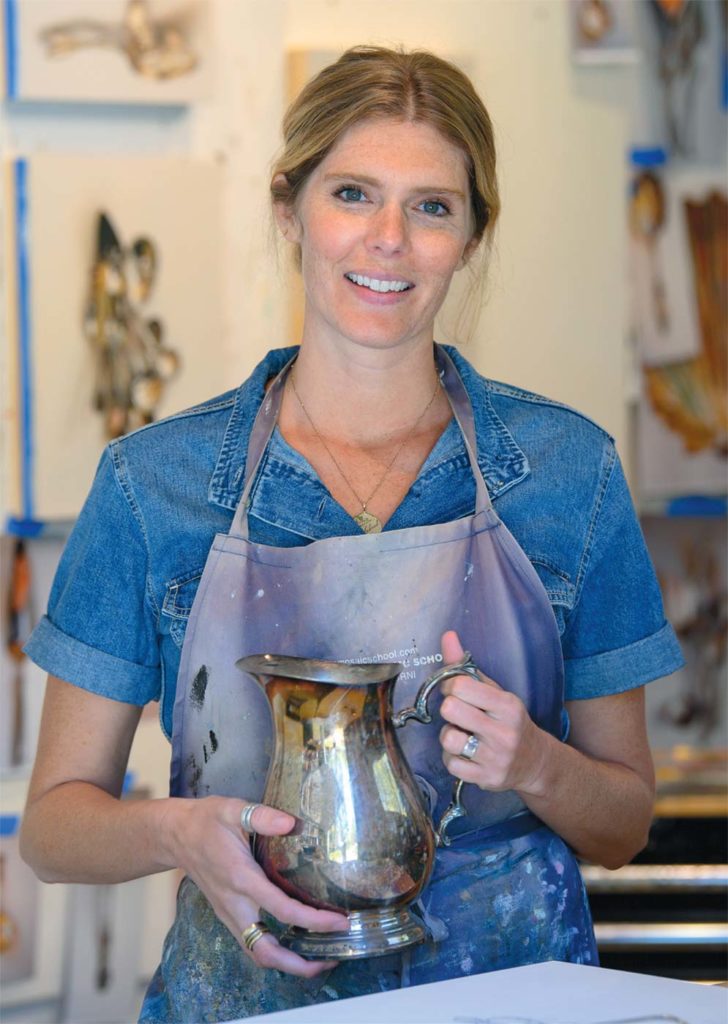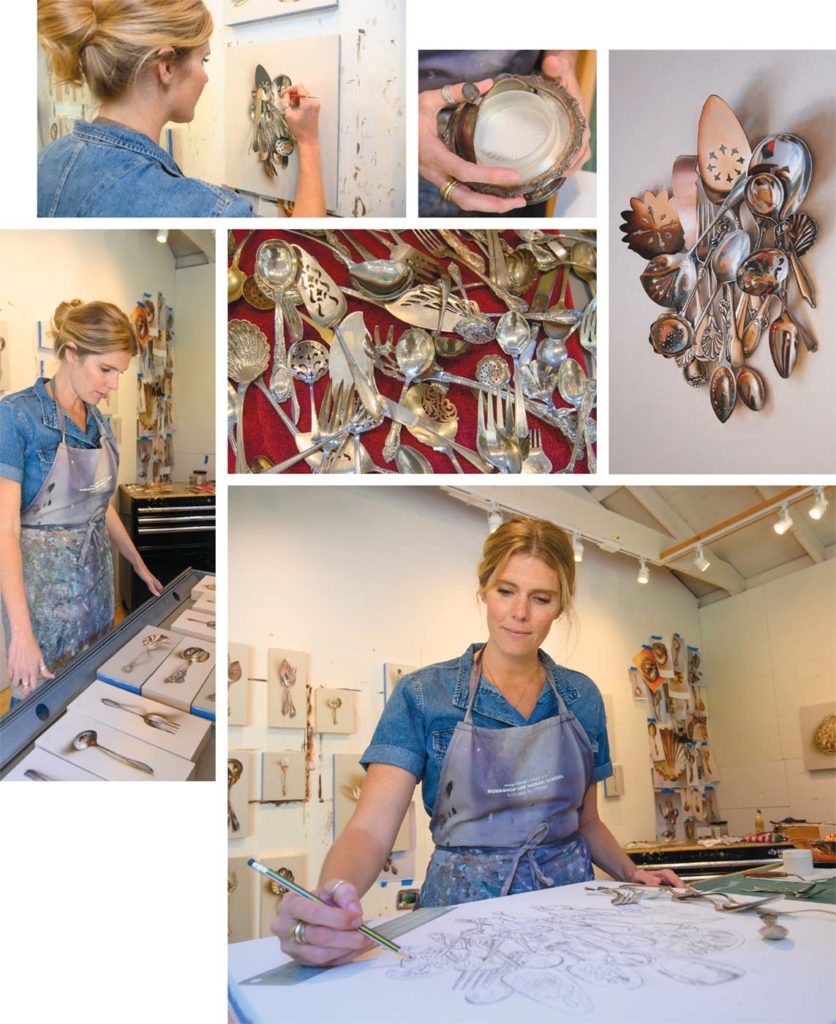PHOTOGRAPHY BY MICHAEL TROUTMAN

Soquel artist finds reflections of family in heirloom silver
It all started with gifts of silverware from her grandmother, at a time when she was too young to realize the significance of such items. But she treasured them nonetheless.
For Leslie Lewis Sigler, it isn’t just about owning these precious mementos— it was the start of what would become her artistic inspiration.
The Soquel artist has become known at galleries across the country for her still-life paintings of antique serving ware, a simple subject that becomes infinitely more complex as Sigler explains how she creates her work.
During the pandemic, the thoughts and emotions behind each piece deepened and evolved as she concentrated on her work during long lonely days, separated from her extended family in Texas.
“I felt this deep longing to gather with my family, but I couldn’t,” recalls Sigler. “I grouped these objects that represented that longing, that feeling of wanting to join with family around the table again.”
In her artist’s studio, drawers hold a motley assortment of silver plated pickle forks, berry spoons, salad servers and butter knives, all pieces that serve as potential subject matter for her paintings.
She holds up a finely made piece with a serrated edge and intricate design, which she thinks is a macaroni server. For some of the beautifully crafted serving ware, she’s not 100% sure of the exact use. Amazingly, there were very specific uses assigned to some pieces, such as the tomato server, the nut server and a spoon specifically made for dusting powdered sugar on pastries or fruit. “You tap it,” says Sigler, for the sugar to fall just so. Another rare piece she received from her grandmother was a butter chiller—a round dish with a hidden compartment for ice to cool the butter above.
Sigler has kept items not only from her own family and her husband’s family, but also over the years, she acquired pieces from friends who gave them to her “because they know I paint silver.” She also borrows items occasionally from Hall’s Surrey House Antiques in Soquel with the owner’s permission, and he’s also been helpful in identifying some of the oddball items.

“Their use is long gone, but I’m honoring their history.”
Many of these unique serving ware designs were created in the late 1800s and early 1900s, a nod to a more genteel time when the upper middle class put a high value on entertaining in just the right way with the most precise implements for a variety of fancy foods.
These days, there’s a more minimalist approach to setting a table, so this era of elaborate serving pieces has passed. But Sigler’s fascination with them keeps alive a telltale sign of that time.
“Their use is long gone, but I’m honoring their history,” she says.
Sigler starts her process by arranging and rearranging serving ware pieces in a variety of ways. She often paints individual portraits of many of the more obscure pieces, the ones where you have to guess their function.
Now, she has entered a phase where she groups more ordinary pieces in different ways, hinting at familial relationships between them. There’s one she recently completed of 10 forks of different shapes and sizes, some polished and others tarnished from age. And there is the series of paired items, usually a large serving spoon and fork, typically complementary but not exactly alike. Sigler calls these “brothers and sisters.”
When she finds combinations of implements that she likes, she photographs them, then draws a study and paints them in oils on board. Sigler deliberately keeps the backgrounds extremely simple, putting the entire focus on the serving ware. The painted still lifes are very close to photorealism, showing the reflections of colors and sometimes reflected items in the studio environment, such as windows or a glimpse of the artist herself.
She starts with a monochromatic painting and then adds color in light and dark layers. Sigler thinks of the pieces as people, and comes up with intriguing names for her paintings, such as “The Mystic” and “The Dilettante.”
Originally from the hill country of Texas, Sigler studied painting at the University of Texas at Austin, and moved to Soquel with her husband four years ago. Her work is represented by galleries in Texas, South Carolina and Connecticut, as well as at Curated By The Sea in downtown Santa Cruz. She’ll have a solo exhibition at the Sullivan Goss art gallery in Santa Barbara from July 1–Aug. 22.
With two young sons and a busy painting schedule, Sigler is also finding time these days to reconnect with family members whom she hasn’t seen since before the pandemic. She has a new appreciation for those relationships, and that can be seen in her art.
“The root of these pieces is family, gathering and bringing people together,” she says.
Works by Leslie Lewis Sigler
Curated By The Sea
703 Front St., Santa Cruz
curatedbythesea.com
408.250.2224
About the author
Kathryn McKenzie, who grew up in Santa Cruz and now lives on a Christmas tree farm in north Monterey County, writes about the environment, sustainable living and health for numerous publications and websites. She is the co-author of “Humbled: How California’s Monterey Bay Escaped Industrial Ruin.”
- Kathryn McKenziehttps://www.ediblemontereybay.com/author/kamckenzie/
- Kathryn McKenziehttps://www.ediblemontereybay.com/author/kamckenzie/
- Kathryn McKenziehttps://www.ediblemontereybay.com/author/kamckenzie/
- Kathryn McKenziehttps://www.ediblemontereybay.com/author/kamckenzie/



